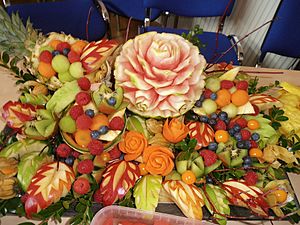Thai fruit carving facts for kids

Thai fruit carving is a beautiful and old art from Thailand. It's like making sculptures, but with fruits and vegetables! This special skill needs a lot of care, focus, and patience. For hundreds of years, fruit carving has been a respected art in Thailand. Long ago, it was mostly used to make royal family tables look amazing. Today, it's still a popular tradition, especially during the Songkran festival, which is the Thai New Year.
Contents
A Look Back in Time: The History of Fruit Carving
Fruit and vegetable carving was a skill taught to women who lived in the Thai royal palace.
There's a famous old story about how this art might have started. Long, long ago, before the Sukhothai era (which was a time in Thai history), a woman named Nang Nopphamat wanted to make her floating lantern extra special. She was preparing for a festival where people floated lanterns on the water. To make her lantern stand out, she used many kinds of flowers. Then, she carved fruits into the shapes of birds and swans. She carefully placed these fruit carvings on the flower petals of her lantern. This made her lantern look more beautiful than anyone else's!
Tools for Carving
Carvers use special tools to create their amazing fruit designs. Often, they use just one main knife for most of the work.
Types of Knives and Other Tools
- Knife
- Round handle Knife
- Plane handle Knife
- Crafting Knife
- Peeler
- Scoop
- Molding tools
- Scissors
- Cutting tools
- Water blow tool (for cleaning or shaping)
- Plate for waste fruit pieces
- Napkin
- Food plastic cover
- Rubber gloves
Fruits Used for Carving
Many different kinds of fruits can be used for carving. They are generally grouped into two main types:
- Thick-skinned fruits: These are fruits like watermelons, pumpkins, or cantaloupes. Their thick skin and firm flesh are great for detailed carvings.
- Thin-skinned fruits: These include fruits like apples, pears, or papayas. They are often used for smaller, more delicate designs.

